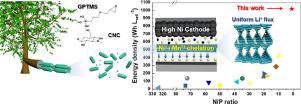Energy Storage Materials ( IF 18.9 ) Pub Date : 2022-06-14 , DOI: 10.1016/j.ensm.2022.06.013 Ji-Young Seo , Yong-Hyeok Lee , Jung-Hui Kim , Young-Kuk Hong , Wenshuai Chen , Young-Gi Lee , Sang-Young Lee

|
Despite their enormous potential as a high-energy-density power source, practical applications of Li-metal batteries have been plagued mainly by poor electrochemical longevity. Here, we present an electrode-customized separator (EC separator) based on self-assembled chiral nematic liquid crystalline cellulose nanocrystal (LC–CNC) as a natural material strategy to simultaneously address the electrochemical reversibility issues of both Li-metal anodes and high-capacity cathodes in Li-metal full cells. The EC separator (thickness ∼ 10 μm) comprises a 3-glycidyloxypropyl trimethoxysilane (GPTMS)-modified LC–CNC layer on a polyethylene (PE) separator support layer. The LC–CNC layer enables facile/uniform Li+ flux toward Li-metal anodes owing to its ordered nanoporous channels and nanofluidic ion migration effect, thus improving Li plating/stripping cyclability. The GPTMS of the LC–CNC layer chelates heavy metal ions dissolved from high-capacity LiNi0.8Co0.1Mn0.1O2 (NCM811) cathodes, thereby enhancing structural stability of the cathodes. The resulting EC separator enables a Li-metal full cell to improve the volumetric energy density (1016 Wh Lcell−1), cycling retention (84% after 100 cycles vs. 0% for the pristine PE separator), and dimensional stability of the Li-metal anode under constrained cell conditions (thin Li-metal anode (20 μm)/high-capacity NCM811 cathode), which outperform those of previously reported synthetic material-based separators for Li-metal full cells.
中文翻译:

基于自组装手性向列液晶纤维素纳米晶体的电极定制隔膜作为可持续锂金属电池的天然材料策略
尽管锂金属电池具有作为高能量密度电源的巨大潜力,但锂金属电池的实际应用主要受到电化学寿命差的困扰。在这里,我们提出了一种基于自组装手性向列液晶纤维素纳米晶体(LC-CNC)的电极定制隔膜(EC隔膜)作为一种天然材料策略,以同时解决锂金属负极和高-锂金属负极的电化学可逆性问题。锂金属全电池中的容量正极。EC 隔膜(厚度约 10 μm)包含聚乙烯(PE)隔膜支撑层上的 3-缩水甘油氧基丙基三甲氧基硅烷(GPTMS)改性的 LC-CNC 层。LC-CNC 层可实现轻松/均匀的 Li +由于其有序的纳米多孔通道和纳米流体离子迁移效应,通量流向锂金属负极,从而提高了锂电镀/剥离循环性。LC-CNC层的GPTMS螯合从高容量LiNi 0.8 Co 0.1 Mn 0.1 O 2 (NCM811)正极中溶解的重金属离子,从而提高正极的结构稳定性。由此产生的 EC 隔膜使锂金属全电池能够提高体积能量密度(1016 Wh L电池-1)、循环保持率(100 次循环后为 84%,而原始 PE 隔膜为 0%)和锂金属负极在受限电池条件下的尺寸稳定性(薄锂金属负极 (20 μm)/高容量 NCM811 正极) ),其性能优于先前报道的用于锂金属全电池的合成材料隔膜。











































 京公网安备 11010802027423号
京公网安备 11010802027423号